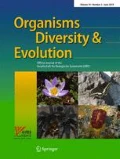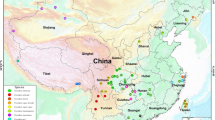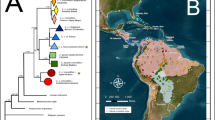Abstract
The endangered African dwarf crocodile Osteolaemus tetraspis is distributed in Central and Western Africa. Conventionally, two subspecies were distinguished: Osteolaemus tetraspis tetraspis and Osteolaemus tetraspis osborni. The taxonomic significance of diagnostic morphological characters is still being discussed and the existence of additional species in the Osteolaemus group remains unclear. Recent molecular studies suggest the existence of three allopatric species in the genus Osteolaemus. These results supported a division of the dwarf crocodile into a Congo Basin form (O. osborni), an Ogooué Basin form (O. tetraspis), and a third separate evolutionary lineage from Western Africa. Several European zoos host African dwarf crocodiles. For reasons of conservation and possible reintroduction, it is important to clarify provenance of these zoo animals. Therefore, we conducted molecular and phylogenetic analyses of three mitochondrial and two nuclear gene sequences with all available samples from European zoos and museums. We also estimated the origin of the zoo animals by comparing sequences of wild animals and museum samples of known provenance. Our study strongly supports three distinct lineages of Osteolaemus as recently postulated, but also reveals a fourth evolutionary lineage. We demonstrate that, of the European zoo animals sampled, only one dwarf crocodile corresponds to the Congo Basin form (O. osborni) whereas the majority of individuals correspond to the three other forms. Four zoo animals belong to the new fourth group; but their provenance is still unresolved. The origin of these animals is probably located in an African region from which no wild animal samples are currently available. Further investigations and sampling of other regions should be completed to clarify the identity of this fourth lineage. We found potential hybrids from European zoological gardens using nuclear DNA sequences. The European Studbook will use these results for further breeding programmes to keep genetically suitable ex-situ populations as reassurance colonies for prospective reintroduction into African countries.



Similar content being viewed by others
References
Academy of natural sciences of philadelphia. 1860. [December 11th]. Proceedings of the Academy of National Sciences of Philadelphia, 12, 548–551.
Altekar, G., Dwarkadas, S., Huelsenbeck, J. P., & Ronquist, F. (2004). Parallel Metropolis coupled Markov chain Monte Carlo for Bayesian phylogenetic inference. Bioinformatics, 20, 407–415.
Ballard, J. W. O., & Whitlock, C. M. (2004). The incomplete natural history of mitochondria. Molecular Ecology, 13, 729–744.
Brochu, C. A. (2007). Morphology, relationships, and biogeographical significance of an extinct horned crocodile (Crocodylia, Crocodylidae) from the Quaternary of Madagascar. Zoological Journal of the Linnean Society, 150(4), 835–863.
Brown, W. M., George, M., & Wilson, A. C. (1979). Rapid evolution of animal mitochondrial DNA. Proceedings of the National Academy of Sciences, 76, 1967–1971.
Clement, M., Posada, D., & Crandall, K. A. (2000). TCS: a computer program to estimate gene genealogies. Molecular Ecology, 9, 1657–1659.
Crocodile Specialist Group (1996). Osteolaemus tetraspis. IUCN 2011. IUCN Red List of Threatened Species. Version 2011.1.
Dathe, H. (1978). The Meaning and Value of Breeds Representing Pure Subspecies in Zoological Gardens. Der Zoologische Garten NF, 48(2/3), 164–166.
Eaton, M. J., Martin, A., Thorbjarnarson, J., & Amato, G. (2009). Species-level diversification of African dwarf crocodiles (Genus Osteolaemus): a geographic and phylogenetic perspective. Molecular Phylogenetics and Evolution, 50, 496–506.
Eaton, M. J., Meyer, G. E., Kolokotronis, S. O., Leslie, M. S., Martin, P. A., & Amato, G. (2009). Barcoding bushmeat: molecular identification of Central African and South American harvested vertebrates. Conservation Genetics, 11, 1389–1404.
Ence, D. D., & Carstens, B. C. (2010). SpedeSTEM: a rapid and accurate method for species delimitation. Molecular Ecology Ressources, 11, 473–480.
Felsenstein, J. (1985). Confidence limits on phylogenies: an approach using the bootstrap. Evolution, 39, 783–791.
Gatesy, J., Baker, R. H., & Hayashi, C. (2004). Inconsistencies in arguments for the supertree approach: supermatrices versus supertrees of Crocodylia. Systematic Biology, 53(2), 342–355.
Hajibabaei, M., Janzen, D. H., Burns, J. M., Hallwachsm, W., & Hebert, P. D. N. (2006). DNA barcodes distinguish species of tropical Lepidoptera. Proceedings of the National Academy of Sciences, 103, 968–971.
Hajibabaei, M., Singer, G. A. C., Hebert, P. D. N., & Hickey, D. A. (2007). DNA barcoding: How it complements taxonomy, molecular phylogenetics and population genetics. Trends in Genetics, 23(4), 167–172.
Hall, T. A. (1999). BioEdit: A user-friendly biological sequence alignment editor and analysis program for Windows 95/98/NT. Nucleic Acids Symposium Series, 41, 95–98.
Hart, M. W., & Sunday, J. (2007). Things fall apart: biological species form unconnected parsimony networks. Biology Letters, 3, 509–512.
Hart, M. W., Keever, C. K., Dartnall, A. J., & Byrne, M. (2006). Morphological and genetic variation indicate cryptic species within Lamarck’s little sea star, Parvulastra (= Patiriella) exigua. The Biological Bulletin, 210, 158–167.
Hebert, P. D. N., Ratnasingham, S., & de Waard, J. R. (2003). Barcoding animal life: cytochrome c oxidase subunit 1 divergences among closely related species. Proceedings of the Royal Society B, 270, 96–99.
Hekkala, E., Shirley, M. H., Amato, G., Austin, J. D., Charter, S., Thorbjarnarson, J., Vliet, K. A., Houck, M. L., DeSalle, R., & Blum, M. J. (2011). An ancient icon reveals new mysteries: mummy DNA resurrects a cryptic species within the Nile crocodile. Molecular Ecology, 20, 4199–4215.
Huelsenbeck, J. P., & Ronquist, F. (2001). MRBAYES: Bayesian inference of phylogenetic trees. Bioinformatics, 17, 754–755.
Inger, R. F. (1948). The systematic status of the crocodile Osteoblepharon osborni. Copeia, 1, 15–19.
Janke, A., Gullberg, A., Hughes, S., Aggarwal, R., & Arnason, U. (2005). Mitogenomic analyses place the gharial (Gavialis gangeticus) on the crocodile tree and provide pre-K/T divergence times for most crocodilians. Journal of Molecular Evolution, 61, 620–626.
Kälin, J. A. (1933). Beiträge zur vergleichenden Osteologie des Crocodilidenschadels. Zoologisches Jahrbuch Anatomie, 57, 535–714.
Katoh, K., Kuma, K., Toh, H., & Mitaya, T. (2005). MAFFT version 5: improvement in accuracy of multiple sequence alignment. Nucleic Acids Research, 33(2), 511–518.
Kimura, M. (1980). A simple method for estimating evolutionary rate of base substitutions through comparative studies of nucleotide sequences. Journal of Molecular Evolution, 16, 111–120.
King, F. W., & Burke, R. L. (1989). Crocodilian, Tuatara, and Turtle Species of the World. Washington, DC: Association of Systematics Collections.
Lacy, R. (1991). Zoos and the surplus problem: an alternative solution. Zoo Biology, 10, 293–297.
Letunic, I., & Bork, P. (2006). Interactive Tree Of Life (iTOL): an online tool for phylogenetic tree display and annotation. Bioinformatics, 23(1).
Letunic, I., & Bork, P. (2011). Interactive Tree Of Life v2: online annotation and display of phylogenetic trees made easy. Nucleic Acids Research. doi:10.1093/nar/gkr201.
Marker-Kraus, L., & Grisham, J. (1993). Captive Breeding of Cheetahs in North American Zoos: 1987–1991. Zoo Biology, 12, 5–18.
McAliley, L. R., Willis, R. E., Ray, D. A., White, P. S., Brochu, C. A., & Densmore, L. D., III. (2006). Are crocodiles really monophyletic?—Evidence for subdivisions from sequence and morphological data. Molecular Phylogenetics and Evolution, 3, 16–32.
Meganathan, P. R., Dubey, B., Batze, M. A., Ray, D. A., & Haque, I. (2010). Molecular phylogenetic analyses of genus Crocodylus (Eusuchia, Crocodylia, Crocodylidae) and the taxonomic position of Crocodylus porosus. Molecular Phylogenetics and Evolution, 57, 393–402.
Meredith, R. W., Hekkala, E. R., Amato, G., & Gatesy, J. (2011). A phylogenetic hypothesis for Crocodylus (Crocodylia) based on mitochondrial DNA: evidence for a trans-Atlantic voyage from Africa to the New World. Molecular Phylogenetics and Evolution, 60, 183–191.
Mertens, R. (1943). Die rezenten Krokodile des Natur-Museums Senkenberg. Senckenbergiana, 26, 252–312.
Mishler, B. D., & Theriot, E. C. (2000). The phylogenetic species concept (sensu Mishler and Theriot). In Q. D. Wheeler & N. Platnick (Eds.), Species concepts and phylogenetic theory (pp. 44–54). New York: Columbia University Press.
Monaghan, M. T., Balke, M., Pons, J., & Vogler, A. P. (2006). Beyond barcodes: complex DNA taxonomy of a south Pacific island radiation. Proceedings of the Royal Society B, 273, 887–893.
Morando, M., Avila, L. J., & Sites, J. W. (2003). Sampling strategies for delimiting species: genes, individuals, and populations in the Liolaemus elongates-kriegi complex (Squamata: Liolaemidae) in the Andean–Patagonian South America. Systematic Biology, 52, 159–185.
Oaks, J. R. (2011). A time-calibrated species tree of Crocodylia reveals a recent radiation of the true crocodiles. Evolution, 65–11, 3285–3297.
Page, R. D. (1996). TreeView: an application to display phylogenetic trees on personal computers. Computer Applications in the Biosciences, 12(4), 357–358.
Pons, J., Barraclough, T. G., Gomez-Zurita, J., Cardoso, A., Duran, D. P., Hazell, S., Kamooun, S., Sumlin, W. D., & Vogler, A. P. (2006). Sequence-based species delimitation for the DNA taxonomy of undescribed insects. Systematic Biology, 55, 595–609.
Ratnasingham, S., & Hebert, P. D. N. (2007). BOLD: the barcode of life data system. Molecular Ecology Notes, 7(3), 355–364.
Ray, D. A., White, P. S., Duong, H. V., Cullen, T., & Densmore, L. D. (2000). High levels of genetic variability in West African dwarf crocodiles Osteolaemus tetraspis tetraspis. In G. C. Grigg, F. Seebacher, & C. E. Franklin (Eds.), Crocodilian Biology and Evolution (pp. 58–63). Australia: Beatty, Chipping Norton.
Rodriguez, F., Oliver, J. L., Marin, A., & Medina, J. R. (1990). The general stochastic model of nucleotide substitution. Journal of Theoretical Biology, 142, 485–501.
Ronquist, F., & Huelsenbeck, J. P. (2003). MrBayes 3: Bayesian phylogenetic inference under mixed models. Bioinformatics, 19, 1572–1574.
Ross, F. D. (2006). African dwarf-croc quandary persists. Crocodile Specialist Group Bulletin, 25(1), 19–21.
Saccone, C., De Giorgi, C., Gissi, C., Pesole, G., & Reyes, A. (1999). Evolutionary genomics in Metazoa: the mitochondrial DNA as a model system. Gene, 238, 195–209.
Schmidt, K. P. (1919). Contributions to the herpetology of the Belgian Congo based on the collection of the American Museum Congo Expedition, 1909–1915. Part 1. Turtles, crocodiles, lizards, and chameleons. Bulletin American Museum of Natural History, 39, Reprint 1998 Society for the Study of Amphibians and Reptiles, 420–435.
Schmitz, A., Mansfield, P., Hekkala, E., Shine, T., Nickel, H., Amato, G., & Böhme, W. (2003). Molecular evidence for species level divergence in African Nile crocodiles Crocodylus niloticus (Laurenti, 1786). Evolution (General Phylogenetics and systematic Theory). Comptes Rendus Palevol, 2, 703–712.
Shirley, M., & Eaton, M. J. (2010). African biogeography and its impact on recent developments in the systematics of African crocodiles. Crocodiles: Actes du 2ème Congrès du Groupe des Spécialistes des Crocodiles sur la promotion et la conservation des crocodiliens en Afrique de l’Ouest ténu à Nazinga, Burkina Faso du 2–6 mars 2010, 89–99.
Stamatakis, A. (2006). RAxML-VI-HPC: Maximum likelihood-based phylogenetic analyses with thousands of taxa and mixed models. Bioinformatics, 22, 2688–2690.
Swiss World atlas (2010-2012). http://schweizerweltatlas.ch/swa_resources/swa_unterrichtsmaterialien/AFR_Gewaesser_Relief_Staatsgrenzen.jpg. Accessed 4 November 2010.
Swofford, D. L. (2002). PAUP*. Phylogenetic Analysis Using Parsimony (*and Other Methods). Version 4. Sinauer, Sunderland, Massachusetts.
Tamura, K., Dudley, J., Nei, M., & Kumar, S. (2007). MEGA4: molecular evolutionary genetics analysis (MEGA) software version 4.0. Molecular Biology and Evolution, 24(8), 1596–1599.
Trutnau, L., & Sommerlad, R. (2006). Krokodile—Biologie und Haltung. Frankfurt: Chimaira.
Van Bemmel, A. C. V. (1971). Keeping and breeding of pure subspecies in Zoos and National Parks. Der Zoologische Garten NF, 40(3), 160–162.
Wangchuk, T., Inouye, D. W., & Hare, M. P. (2008). The emergence of an endangered species: evolution and phylogeny of the Trachypithecus geei of Bhutan. International Journal of Primatology, 29, 565–582.
Wermuth, H. (1953). Systematik der rezenten Krokodile. Mitteilungen des Zoologischen Museum Berlin, 28(2), 458–467.
Wermuth, H., & Mertens, R. (1961). Schildkröten, Krokodile und Brückenechsen. Gustav Fischer Verlag Jena, Nachdruck, 1996, 422.
Wiens, J. J., & Penkrot, T. A. (2002). Delimiting species using DNA and morphological variation and discordant species limits in spiny lizards (Sceloporus). Systematic Biology, 51, 69–91.
Wilson, A. C., Cann, R. L., Carr, S. M., George, M., Gyllensten, U. B., Helm-Bychowski, K. M., Higuchi, R. G., Palumbi, S. R., Prager, E. M., Sage, R. D., & Stoneking, M. (1985). Mitochondrial DNA and two perspectives on evolutionary genetics. Biological Journal of the Linnean Society London, 26, 375–400.
Zhang, C., Zhang, D.-X., Zhu, T., & Yang, Z. (2011). Evaluation of a Bayesian coalescent method of species delimitation. Systematic Biology, 60, 747–761.
Zoer, R. (2010). A final report to the Conservation Agency. Prins Bernhard Cultuurfonds, Stichting Fundatie van de Vrijvrouwe van Renswoude. Dutch Zoo Conservation Fund.
Acknowledgements
We would like to thank all the zoological gardens in Europe and Toronto, Canada, and the natural historical museums in Hamburg, Bonn, Vienna, and Basel that provided blood and tissue samples. We gratefully acknowledge private breeders and institutions for supplying blood samples. We are grateful to the Zoo Leipzig GmbH, Germany for support and organization during this study. We acknowledge Mitchell Eaton for transmitting sequence data of wild animals and for helpful comments on the manuscript. We acknowledge Matthew Shirley, who provided samples from West Africa (Ghana and Côte d´Ivoire) via Mitchell Eaton (personal communication and Eaton el al. 2009a). We would also like to thank Prof. Dr. Ernst Spiess and Dr. Christian Häberling for providing the map of Africa (© SWISS WORLD ATLAS 2010–2012). In addition, we thank Michael Weidhase and Annemarie Geißler for supporting the laboratory work; we also thank Kevin M. Kocot, who provided helpful comments and Michael Gerth for bioinformatics assistance. We also acknowledge the reviewers for their valuable comments on the manuscript and their constructive suggestions.
Author information
Authors and Affiliations
Corresponding author
Electronic supplementary material
Below is the link to the electronic supplementary material.
ESM 1
(PDF 1.11 mb)
Rights and permissions
About this article
Cite this article
Franke, F.A., Schmidt, F., Borgwardt, C. et al. Genetic differentiation of the African dwarf crocodile Osteolaemus tetraspis Cope, 1861 (Crocodylia: Crocodylidae) and consequences for European zoos. Org Divers Evol 13, 255–266 (2013). https://doi.org/10.1007/s13127-012-0107-1
Received:
Accepted:
Published:
Issue Date:
DOI: https://doi.org/10.1007/s13127-012-0107-1




